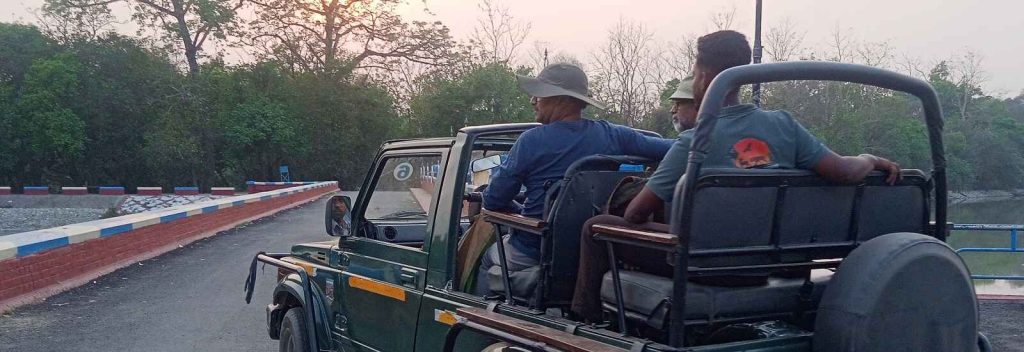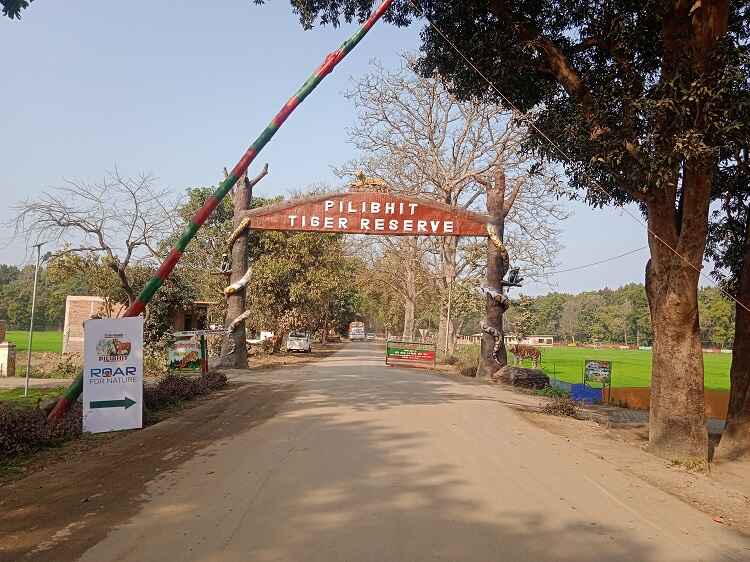The Pilibhit Tiger Reserve is one of the most beautiful destinations, which lies in the green land of Terai in Uttar Pradesh, and is a paradise for a pleasure trip, nature, and photographers. Along with its flourishing Bengal tigers, swamp deer, and leopard populations, as well as its more than 400 varieties of birds, the reserve provides a distinctive wild experience. The forest is closed in monsoon, but nonetheless, every season offers its own beauty and star attractions in Pilibhit Tiger Reserve. Now we will provide a full seasonal guide to get a clear understanding of which time suits you better to visit Pilibhit Tiger Reserve in case of your future jungle adventure.
Winter ( November to February) is the best time to go on safari – Prime Safari Season
Winter is the best time to visit the Pilibhit Tiger Reserve for a jungle safari and birdwatching, it is prime safari season due to cool weather.
Weather and Environment:
The temperatures during this time are between 8 degrees and 22 degrees, hence this is the season that favours outdoor activities. It is morning in the forest, and thereupon, mist covers the entire woods, giving it a mysterious and magical feel to the entire place, and boom! This is where you want to take the photos of wildlife.
Wildlife Highlights:
![]() The animals are active during the day.
The animals are active during the day.
![]() Observation of tigers. The chances of seeing a tiger increase in areas with a water source and spots where there is sunlight.
Observation of tigers. The chances of seeing a tiger increase in areas with a water source and spots where there is sunlight.
![]() A birdwatching paradise since migratory birds seek refuge at the place in numbers exceeding expectations of bar-headed geese, painted storks, and Eurasian spoonbills.
A birdwatching paradise since migratory birds seek refuge at the place in numbers exceeding expectations of bar-headed geese, painted storks, and Eurasian spoonbills.
![]() Wild boars and swamp deer (barasingha) can be easily seen grazing in open grassland.
Wild boars and swamp deer (barasingha) can be easily seen grazing in open grassland.
Best Activities:
![]() Gypsy jungle safari on the Mahof and Chuka ranges in the morning and in the evening.
Gypsy jungle safari on the Mahof and Chuka ranges in the morning and in the evening.
![]() Flora and fauna stroll and camera tours.
Flora and fauna stroll and camera tours.
![]() Trips to the Chuka Beach to see the river stream and have picnics.
Trips to the Chuka Beach to see the river stream and have picnics.
![]() Visiting Jhand Tal and Barasingha Tal to get rich bird life.
Visiting Jhand Tal and Barasingha Tal to get rich bird life.

Spring (March to April): Blooming Wilderness
Spring moves the forest on its way through winter cold toward sunny summer weather, which varies between 15 -30 °C. Pilibhit is still pretty good to visit in terms of nature.
Wildlife Highlights:
![]() The forest begins flowering with new leaves, increasing the opportunity for photosynthesis.
The forest begins flowering with new leaves, increasing the opportunity for photosynthesis.
![]() Animals visit waterholes more frequently, and such wildlife sightings are common.
Animals visit waterholes more frequently, and such wildlife sightings are common.
![]() Well suited to study courtship, bird habits, and nesting.
Well suited to study courtship, bird habits, and nesting.
![]() Sometimes, a tiger and a leopard were seen near the dry course.
Sometimes, a tiger and a leopard were seen near the dry course.
Best Activities:
![]() Going on safaris to catch a glimpse of predators and herbivores in the early morning.
Going on safaris to catch a glimpse of predators and herbivores in the early morning.
![]() Chuka Beach, at sunset and the end of an adventurous day.
Chuka Beach, at sunset and the end of an adventurous day.
![]() Hiking, camping, or staying in eco huts on the edge of the forest.
Hiking, camping, or staying in eco huts on the edge of the forest.
![]() Bird photography at Tal and Jhand Sapt Sarovar.
Bird photography at Tal and Jhand Sapt Sarovar.
Summer (May to June): To the Serious Wildlife Enthusiast
The Pilibhit summer is dry and hot, with temperatures rising up to 30-42 °C. It may not be the most comfortable season of the year for everyone, but it is a favorite among wildlife photographers and serious safari people.
Wildlife Highlights:
![]() Fine spots of tiger sighting because of less forest cover and animals coming to the water holes.
Fine spots of tiger sighting because of less forest cover and animals coming to the water holes.
![]() Some of the animals that can be seen out in the field include a leopard, jackals, nilgai, and swamp deer.
Some of the animals that can be seen out in the field include a leopard, jackals, nilgai, and swamp deer.
![]() There are fewer tourists, which makes the experience more peaceful and intimate.
There are fewer tourists, which makes the experience more peaceful and intimate.
![]() Opportunity to observe more active reptiles and amphibians during evenings.
Opportunity to observe more active reptiles and amphibians during evenings.
Tips:
![]() Wear light and breathable clothes always, drink a lot of water, and take sunscreen with you.
Wear light and breathable clothes always, drink a lot of water, and take sunscreen with you.
![]() Choose early morning and late evening safaris to avoid high temperatures.
Choose early morning and late evening safaris to avoid high temperatures.
Monsoon (July to Mid-November)
Closed Season of Wildlife tourism: During the monsoon, the reserve is officially closed to visitors because of heavy rain and slippery tracks, and it is the breeding season of the wild animals. But this stage is very important to the ecological restoration of the forest.
Nature Highlights:
![]() The forest turns luscious green and revitalized.
The forest turns luscious green and revitalized.
![]() Rivers and streams are also filled up, sustaining water life and plants.
Rivers and streams are also filled up, sustaining water life and plants.
![]() Breeding period of the tiger, leopard, deer, and other bird species.
Breeding period of the tiger, leopard, deer, and other bird species.
![]() The monsoon period maintains a healthy ecological system even though nobody is allowed into the park.
The monsoon period maintains a healthy ecological system even though nobody is allowed into the park.
Festivals and Events
![]() You can also make your vacation rich by visiting during the time of regional holidays:
You can also make your vacation rich by visiting during the time of regional holidays:
![]() Tiger Day (July 29) – Although at readings, awareness programs start at an earlier date, during the closure, awareness is initiated earlier.
Tiger Day (July 29) – Although at readings, awareness programs start at an earlier date, during the closure, awareness is initiated earlier.
![]() Closure may precede events and guided walks, which are sometimes organized during the wildlife week (October 28) and during other periods throughout the year.
Closure may precede events and guided walks, which are sometimes organized during the wildlife week (October 28) and during other periods throughout the year.
![]() The additional attraction can be local fairs, religious festivities near Chuka Beach, or temples.
The additional attraction can be local fairs, religious festivities near Chuka Beach, or temples.
Travel Tips on All Seasons
![]() It is always advisable that you make your reservations even for safaris, particularly on weekends and holidays.
It is always advisable that you make your reservations even for safaris, particularly on weekends and holidays.
![]() To have a good experience, hire official guides or naturalists.
To have a good experience, hire official guides or naturalists.
![]() Bring binoculars and a camera to photograph birds and wildlife.
Bring binoculars and a camera to photograph birds and wildlife.
![]() Observe forest rules, no loud voice, no plastic items, and respect nature.
Observe forest rules, no loud voice, no plastic items, and respect nature.
Final words: How to know when to go?
March to June is the best time to go to the park as you have higher odds of seeing the tigers as well as other big mammals, if you are after the ultimate wildlife experience. November to February is cool and diverse in wildlife for bird watchers and nature lovers. Pilibhit Tiger Reserve can do many different things in each season, which makes the place an all-year-round nature destination (except monsoon). It does not matter whether you are in pursuit of the roar of the tiger or the song of exotic birds, Pilibhit will open its arms and offer you wild wonders.


 How To Reach At PTR
How To Reach At PTR